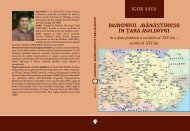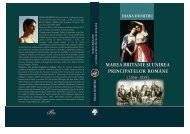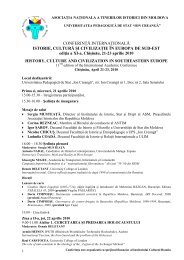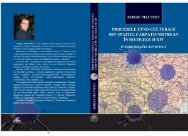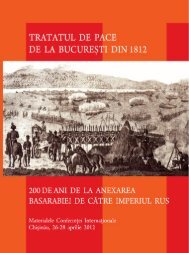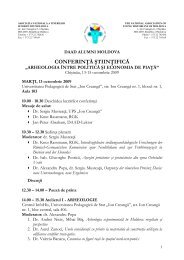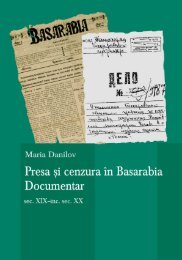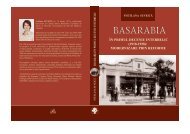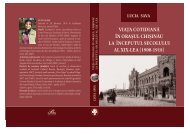Publicatie cu continut integral - Asociatia Tinerilor Istorici din Moldova
Publicatie cu continut integral - Asociatia Tinerilor Istorici din Moldova
Publicatie cu continut integral - Asociatia Tinerilor Istorici din Moldova
Create successful ePaper yourself
Turn your PDF publications into a flip-book with our unique Google optimized e-Paper software.
utilizează fonduri de stat – au înţeles importanţa punerii în valoare a structurilor istorice naţionale şi nu numai<br />
(drept mărturie, o serie de proiecte desfăşurate pentru salvarea unor situri în ţări <strong>din</strong> America de Sud, state în care<br />
guvernele – <strong>din</strong> lipsă de fonduri sau înţelegere, sau ambele – nu se implică în menţinerea vechii moşteniri şi pierd<br />
<strong>din</strong> vedere cît de însemnată este aceasta pentru generaţiile viitoare).<br />
Un ultim plan al dublei implicări şi colaborări este înregistrat în zilele noastre: arheologii forensici reconstituie<br />
profilul crimelor prin analiza evidenţelor fizice 1 : în literatura de specialitate, Kottak vorbeşte de o antropologie<br />
a masacrului 2 , exemplificând <strong>cu</strong> un caz de ucidere în masă în Guatemala anului 1982, caz do<strong>cu</strong>mentat atât de arheologi,<br />
cît şi de legişti. Într-o astfel de împrejurare – mărturisea un arheolog implicat, situaţia este asemănătoare<br />
celei de excavare a unui sit arheologic; odată <strong>cu</strong> s<strong>cu</strong>rgerea timpului, ca şi în acesta <strong>din</strong> urmă, survin modificări,<br />
distrugeri, interpretarea rămăşiţelor dove<strong>din</strong>du-se la fel de anevoioasă, chiar dacă nu avem de-a face <strong>cu</strong> o arheologie<br />
de tip academic.<br />
Departe de pretenţia exhaustivităţii, am încercat să schiţăm teritoriul de convergenţă al celor două ştiinţe, în<br />
condiţiile în care în România, antropologia a fost introdusă de foarte puţină vreme în sistemul de învăţămînt,<br />
arheologia beneficiind de un <strong>cu</strong> tot alt background. Cu siguranţă, o parte <strong>din</strong> cele prezentate mai sus se situează<br />
încă la nivelul dezideratului: considerăm, însă, că tocmai promovarea unei serii de aspecte ce ţin de interferenţa<br />
antropologiei <strong>cu</strong> arheologia poate reprezenta un prim pas pentru transpunerea în realitate, atît în folosul cercetării<br />
ştiinţifice, cît şi al publi<strong>cu</strong>lui larg.<br />
Summary<br />
The last decades of the previous century have proposed – through the work of American anthropologist P. Kottak.<br />
– the collocation archaeological anthropology; the author simplifies the concept and explains that we deal<br />
with archaeology, understood and practiced accor<strong>din</strong>g to North-American standards, in a larger sense. We need<br />
to specify the following: in the New World, the archaeology has always been correlated to <strong>cu</strong>ltural anthropology,<br />
more closely than on our continent. The explanation is that meanwhile the Europeans considered archaeological<br />
research as an extension of their studies from contemporary history to the prehistoric past, the American scientists<br />
have started investigation of foreigner communities by digging their sites and of the local communities (that is<br />
ethnographic research of American native’s community).<br />
At present, this difference still persists: in Europe, the archaeology is usually considered as a humanistic science,<br />
correlated to history science, while in the United States it is practice as an anthropology branch and a social<br />
science.<br />
The classifications and the institutional separation are less important; but it is extremely necessary that both archaeologists<br />
and anthropologists must have serious knowledge of both domains and when this is not possible, the<br />
cooperation is compulsory. For instance, the research of a community is not limited to description anthropological<br />
features but it includes the study of social and historical aspects, for the purpose of emphasizing the community<br />
history, the stratification issues, the social structure, the production forms, the economic level, characteristics of<br />
family life and private life, meaning a study of the complex existence environment where this group lives.<br />
1 KOTTAK 2000, 438.<br />
2 KOTTAK 2000, 440.<br />
– –



